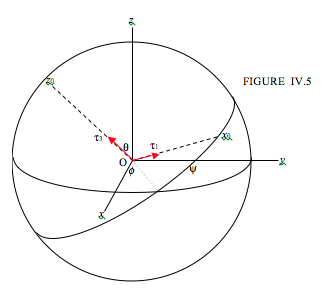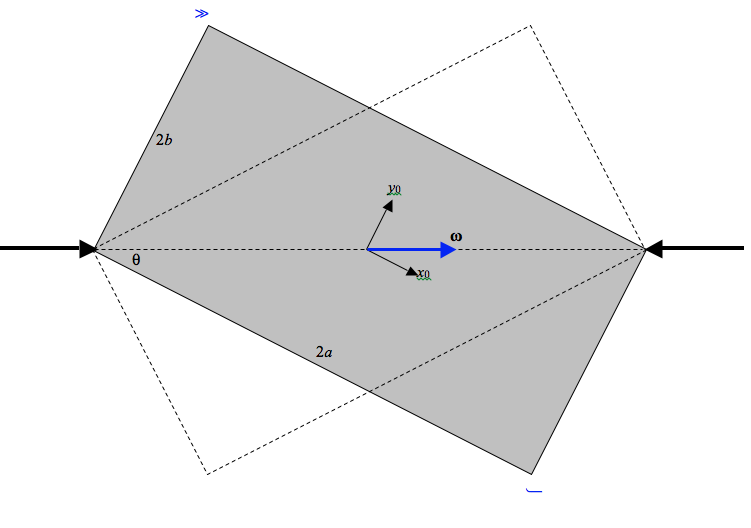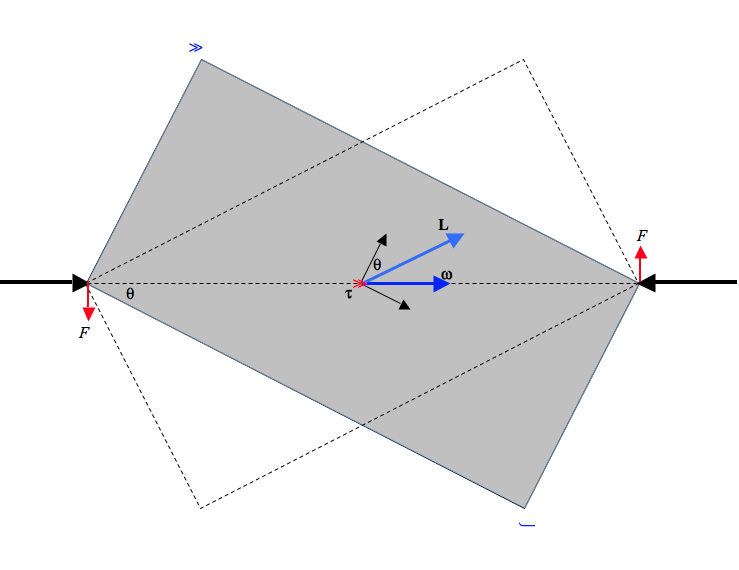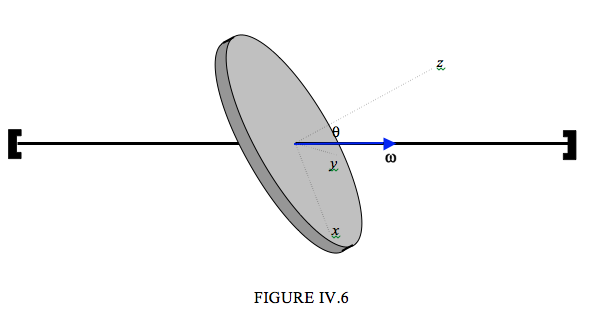4.5: Euler's Equations of Motion
( \newcommand{\kernel}{\mathrm{null}\,}\)
In our first introduction to classical mechanics, we learn that when an external torque acts on a body its angular momentum changes (and if no external torques act on a body its angular momentum does not change.) We learn that the rate of change of angular momentum is equal to the applied torque. In the first simple examples that we typically meet, a symmetrical body is rotating about an axis of symmetry, and the torque is also applied about this same axis. The angular momentum is just Iω, and so the statement that torque equals rate of change of angular momentum is merely τ=I˙ω and that’s all there is to it.
Later, we learn that L = Iω, where l is a tensor, and L and ω are not parallel. There are three principal moments of inertia, and L, ω and the applied torque τ each have three components, and the statement “torque equals rate of change of angular momentum” somehow becomes much less easy.
Euler’s Equations sort this out, and give us a relation between the components of the τ, l and ω.
For Figure IV.5, I have just reproduced, with some small modifications, Figure III.19 from my notes on this Web site on Celestial Mechanics, where I defined Eulerian angles. Again it is suggested that those who are unfamiliar with Eulerian angles consult Chapter III of Celestial Mechanics.
In Figure IV.5, Oxyz are space-fixed axes, and Ox0y0z0 are the body-fixed principal axes. The axis Oy0 is behind the plane of your screen; you will have to look inside your monitor to find it.

I suppose an external torque τ acts on the body, and I have drawn the components τ1 and τ3. Now let’s suppose that the body rotates in such a manner that the Eulerian angle ψ were to increase by δψ . I think it will be readily agreed that the work done on the body is τ3δψ. This means, following our definition of generalized force in Section 4.4, that τ3 is the generalized force associated with the generalized coordinate ψ. Having established that, we can now apply the Lagrangian Equation 4.4.1:
ddt(∂T∂˙ψ)−∂T∂ψ=τ3
Here the kinetic energy is the expression that we have already established in Equation 4.3.6. In spite of the somewhat fearsome aspect of Equation 4.3.6, it is quite easy to apply Equation 4.5.1 to it. Thus
∂T∂˙ψ=I3(˙ϕcosθ+ψ)=I3ω
where I have made use of Equation 4.2.3.
Therefore
ddt(∂T∂˙ψ)=I3˙ω3
And, if we make use of Equations 4.2.1,2,3, it is easy to obtain
∂T∂ψ)=I1ω1ω2−I2ω2ω2=ω1ω2(I1−I2)
Thus Equation 4.5.1 becomes:
I3˙ω3−(I1−I2)ω1ω1=τ3
This is one of the Eulerian Equations of motion.
Now, although we saw that τ3 is the generalized force associated with the coordinate y, it will we equally clear that τ1 is not the generalized force associated with q, nor is τ2 the generalized force associated with ϕ. However, we do not have to think about what the generalized forces associated with these two coordinates are; it is much easier than that. To obtain the remaining two Eulerian Equations, all that is necessary is to carry out a cyclic permutation of the subscripts in Equation 4.5.5. Thus the three Eulerian Equation are:
I1˙ω1−(I2−I2)ω2ω3=τ1,
I2˙ω2−(I3−I1)ω3ω1=τ2,
I3˙ω3−(I1−I2)ω1ω2=τ3.
These take the place of τ=I˙ω which we are more familiar with in elementary problems in which a body is rotating about a principal axis and a torque is applied around that principal axis.
If there are no external torques acting on the body, then we have Euler’s Equations of free rotation of a rigid body:
I1˙ω1=(I2−I3)ω2ω3,
I1˙ω2=(I3−I1)ω3ω1,
I3˙ω3=(I1−I2)ω1ω2.

In the above drawing, a rectangular lamina is spinning with constant angular velocity ω between two frictionless bearings. We are going to apply Euler’s Equations of motion to it. We shall find that the bearings are exerting a torque on the rectangle, and the rectangle is exerting a torque on the bearings. The angular momentum of the rectangle is not constant – at least it is not constant in direction. We shall calculate the torque (its magnitude and its direction) and see what is happening to the angular momentum.
We note that the principal (second) moments of inertia are
I1=13mb2I2=13ma2I3=13m(a2+b2)
and that the components of angular velocity are
ω1=ωcosθω2=ωsinθω3=0.
Also, ˙ω and all of its components are zero. We immediately obtain, from Euler’s Equations, that τ1 and τ2 are zero, and that the torque exerted on the rectangle by the bearings is
τ3=(I2−I1)ω1ω2=13m(a2−b2)ω2sinθcosθ
And since
sinθ=b√a2+b2andcosθ=b√a2+b2,
we obtain
τ3=m(a2−b2)ab3(a2+b2)ω2
Thus τ, the torque exerted on the rectangle by the bearings is directed normal to the plane of the rectangle (out of the plane of the paper in the instantaneous snapshot above).
The angular momentum is given by L=lω. That is to say:
(L1L2L3)=13m(b2000a2000a2+b2)(ωcosθωsinθ0)
L1=13mb2ωcosθ=13mab2√a2+b2ω
L2=13mb2ωsinθ=13mab2√a2+b2ω
L3=0
L=13mabω
L2/L1=a2sinθb2cosθ=cotθ=tan(90°−θ)
This tells us that L is in the plane of the rectangle, and makes an angle 90° - θ with the x-axis, or q with the y-axis, and it rotates around the vector τ. τ is perpendicular to the plane of the rectangle, and of course the change in L takes place in that direction. The torque does no work, and ω and T are constant. The reader might find an analogy in the situation of a planet in orbit around the Sun in a circular orbit.. The planet experiences a force that is always perpendicular to its velocity. The force does no work, and the speed and kinetic energy remain constant.

The torque on the plate can be represented as a couple of forces exerted by the bearings on the plate, each of magnitude τ32√a2+b2, or m(a2−b2)6(a2−b2)32ω2 Forces exerted by the plate on the bearings are, of course, in the opposite direction.

Figure IV.6 shows a disc of mass m, radius a, spinning at a constant angular speed ω about at axle that is inclined at an angle θ to the normal to the disc. I have drawn three body-fixed principal axes. The x- and y- axes are in the plane of the disc\boldsymbol; the direction of the x-axis is chosen so that the axle (and hence the vector ω ) is in the zx-plane. The disc is evidently unbalanced and there must be a torque on it to maintain the motion.
Since ω is constant, all components of ˙ω are zero, so that Euler’s Equations are
τ1=(I3−I2)ω3ω2,
τ2=(I1−I3)ω1ω3,
τ3=(I2−I1)ω2ω1,
Now ω1=ωsinθ,ω2=ωcosθ,I1=14ma2,I2=14ma2,I3=11ma2
Therefore τ1=τ3=0,andτ2=−14ma2ω2sinθcosθ=−18ma2ω2sin2θ
(Check, as always, that this expression is dimensionally correct.) Thus the torque acting on the disc is in the negative y-direction.
Can you reconcile the fact that there is a torque acting on the disc with the fact that is it moving with constant angular velocity? Yes, most decidedly! What is not constant is the angular momentum L, which is moving around the axle in a cone such that ˙L=−τ2j, where j is the unit vector along the y-axis.


